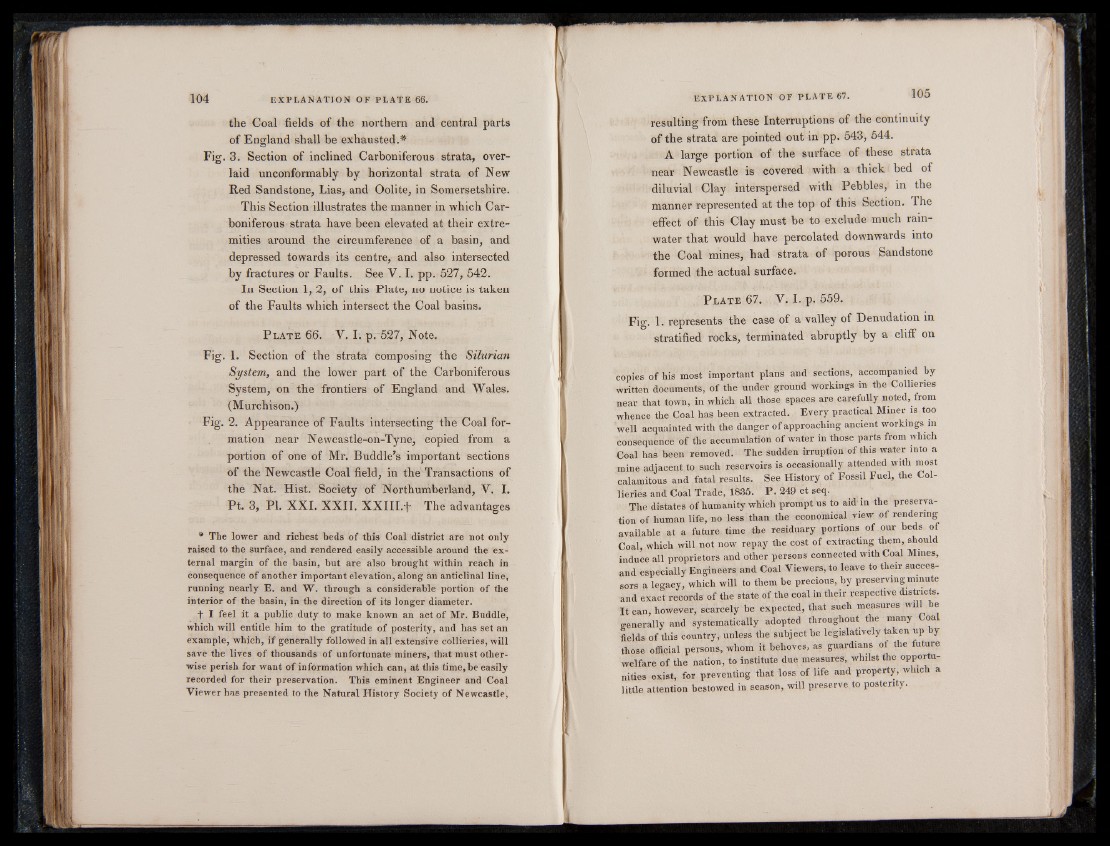
the Coal fields of the northern and central parts
of England shall be exhausted.*
Fig. 3. Section of inclined Carboniferous strata, overlaid
unconformably by horizontal strata of New
Red Sandstone, Lias, and Oolite, in Somersetshire.
This Section illustrates the manner in which Carboniferous
strata have been elevated at their extremities
around the circumference of a basin, and
depressed towards its centre, and also intersected
by fractures or Faults. See V. I. pp. 527, 542.
In Section 1, 2, of this Plate, no notice is taken
of the Faults which intersect the Coal basins.
P l a t e 66. V. I. p. 527, Note.
Fig. 1. Section of the strata composing the Silurian
System, and the lower part of the Carboniferous
System, on the frontiers of England and Wales.
(Murchison.)
Fig. 2. Appearance of Faults intersecting the Coal formation
near Newcastle-on-Tyne, copied from a
portion of one of Mr. Buddie’s important sections
of the Newcastle Coal field, in the Transactions of
the Nat. Hist. Society of Northumberland, V. I.
Pt. 3, PI. XXI. XXII. XXIII.+ The advantages
* The lower and richest beds of this Coal district are not only
raised to the surface, and rendered easily accessible around the external
margin of the basin, but are also brought within reach in
consequence of another important elevation, along an anticlinal line,
running nearly E. and W. through a considerable portion of the
interior of the basin, in the direction of its longer diameter.
+ I feel it a public duty to make known an act of Mr. Buddie,
which will entitle him to the gratitude of posterity, and has set an
example, which, if generally followed in all extensive collieries, will
save the lives of thousands of unfortunate miners, that must otherwise
perish for want of information which can, at this time, be easily
recorded for their preservation. This eminent Engineer and Coal
Viewer has presented to the Natural History Society of Newcastle,
resulting from these Interruptions of the continuity
of the strata are pointed out in pp. 543, 544.
A large portion of the surface of these strata
near Newcastle is covered with a thick bed of
diluvial Clay interspersed with Pebbles, in the
manner represented at the top of this Section. The
effect of this Clay must be to exclude much rainwater
that would have percolated downwards into
the Coal mines, had strata of porous Sandstone
formed the actual surface.
P l a t e 67. V. I. p. 559.
Fig. 1. represents the case of a valley of Denudation in
stratified rocks, terminated abruptly by a cliff on
copies of his most important plans and sections, accompanied by
written documents, of tbe under ground workings in the Collieries
near that town, in which all those spaces are carefully noted, from
whence the Coal has been extracted. Every practical Miner is too
well acquainted with the danger of approaching ancient workings in
consequence of the accumulation of water in those parts from which
Coal has been removed. The sudden irruption of this water into a
mine adjacent to such reservoirs is occasionally attended with most
calamitous and fatal results. See History of Fossil Fuel, the Collieries
and Coal Trade, 1835. P . 249 et seq.
The distates of humanity which prompt us to aid in the preservation
of human life, no less than the economical view of rendering
available at a future time the residuary portions of our beds of
Coal, which will not now repay the cost of extracting them, should
induce all proprietors and other persons connected with Coal Mines,
and especially Engineers and Coal Viewers, to leave to their successors
a legacy, which will to them be precious, by preserving minute
and exact records of the state of the coal in their respective districts.
I t can, however, scarcely be expected, that such measures will e
generally and systematically adopted throughout the many Coal
fields of this country, unless the subject be legislatively taken up y
those official persons, whom it behoves, as guardians of the future
welfare of the nation, to institute due measures, whilst the opportunities
exist, for preventing that loss of life and property, which a
little attention bestowed in season, will preserve to posterity.